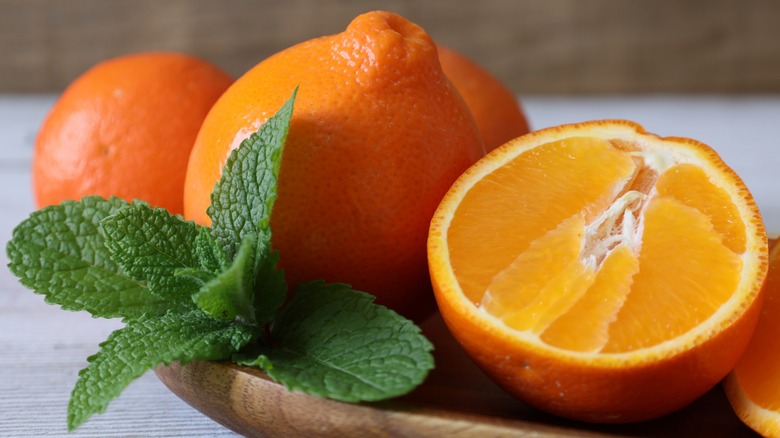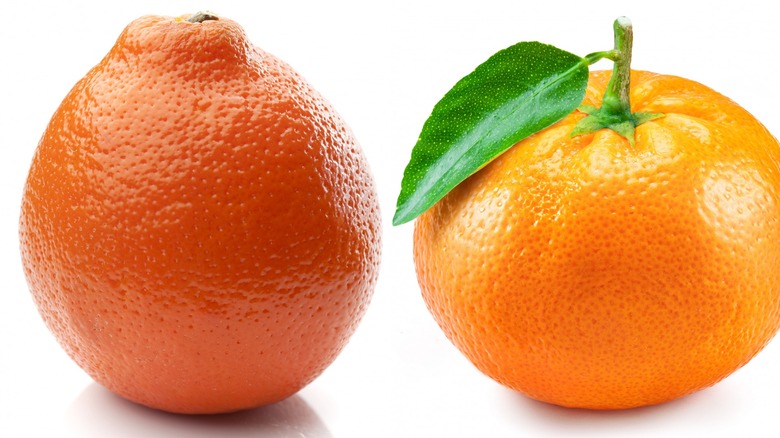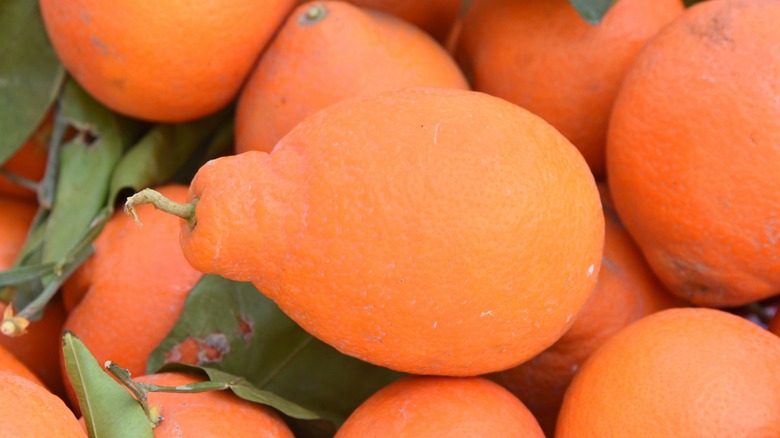If You Love The Citrusy Burst Of Tangerines, You Need To Try Tangelos
Do you ever feel like new types of citrus fruits are constantly hitting the shelves? That's because they exist in a dazzling variety of forms! Nearly 2,500 species and cultivars have been described — and that's no accident. New varieties are created every year, largely through the process of hybridization, which occurs when two different but closely related species or varieties crossbreed with one another.
Citrus plants hybridize frequently, both naturally and through intentional cultivation. Growers are constantly developing new citrus varieties, selectively breeding those that produce fruit that is easy to grow, sturdy, and, of course, delicious. Many popular types, such as the beloved Cara Cara orange, are newfound inventions that only emerged in the last century.
Still, few citrus species are as ancient and ever-evolving as the tangelo (Citrus tangelo). Arising naturally over 3,000 years ago, the tangelo crossbreeds readily and has continued to spawn delectable new types well into the 20th century. With their soft consistency and sweet taste, it's easy to see why citrus fanatics love tangelos. Let's dive into the tasty world of this incredibly flavorful fruit and its many varieties.
Tangelos vs. tangerines
As their name suggests, tangelos emerged as a cross between a tangerine and a pomelo, which is a type of sweet grapefruit. So, it's no surprise that tangerines and tangelos share some characteristics. They both have an eye-catching bright orange color, share a pleasant, sweet flavor, and are easy to peel. But past such commonalities, a few differences emerge.
For starters, tangelos are much larger, coming in at nearly twice the size of a tangerine. They are also less spherical in shape, with a pronounced knob at one end. Tangelos are a bit easier to handle, too, having smoother, thinner skin and predominantly seedless flesh. When it comes to the taste, flavors differ based on the variety, but tangelos usually have a little more tang owing to their grapefruit parent.
Due to their short harvest season, tangelos appear less frequently on grocery store shelves. They are only available for one to two months a year, while tangerines and other citrus fruits are more readily grown regardless of the season. Backed by its sweet, tangy, and delicious flavor, the tangelo's rarity only increases its intrigue.
What do tangelos taste like?
Owing to their mixed parentage, tangelos offer a tasty mix of sweet and tart notes. The tangerine lends its deep, honey-like sweetness, while the pomelo or grapefruit brings a zesty sour punch. Tangelos are often floral, with a palatable complexity that doesn't veer into bold, singular notes, though the flavor profile differs slightly in each variety.
Minneola tangelos (pictured), a popular variety developed in Florida, offer the balanced flavor that tangelos are known for. They boast an equal ratio of sweetness and tartness with a highly aromatic burst of flavor. Meanwhile, the Seminole tangelo ups the citrus's zesty, tart character with bright, aromatic notes that are less sweet-forward. In contrast, Orlando tangelos serve up the mildest flavor of the bunch, with a sustained, pleasantly sweet taste.
Another distinct variety is the Jamaican tangelo, which is appropriately also called the "ugli fruit." While this variety is less aesthetically attractive with its brown-spotted, yellow-green exterior, it boasts a delicious flavor similar to that of the Minneola. Any tangelo variety is worth a bite; they're all dependably mouthwatering.
How to cook with tangelos
Like other varieties of sweet oranges, tangelos are a delicious snack on their own. However, they also work well in a range of applications, both raw and cooked.
Their succulent flesh makes them excellent in fruit salads, paired with tangy fruits like pineapples, grapefruits, or sweet mangos. They can also add a sweet but balanced note to a bright salsa or serve as a fruity base for marmalades, smoothies, cocktails, and other liquid applications. Overripe tangelos that are close to spoilage can even lend their frozen juice to delicious homemade popsicles. You can also take a savory route and use tangelos to accompany fish and other seafood — the fruit's sweet-tart flavor pairs beautifully.
Tangelo rinds are tasty, too, with a palatable zest reminiscent of flavorful lemon and orange varieties. Tangelo rinds can be grated into desserts like bread pudding or offered as a finishing garnish alongside savory dishes. Alternatively, cook down the peels in sugar to make a delicious syrup. Since all parts of the tangelo are edible and delicious, there's no need to let any of them go to waste.
Nutrition of tangelos
As with other citrus fruits, tangelos are an excellent source of nutrition. A single 100-gram serving of Minneola tangelo offers 2.1 grams of fiber, 52.6 milligrams of vitamin C, as well as 42 milligrams of calcium, all while containing only 47 calories. The tangelo's high vitamin C levels — well over half of the daily requirement – aid in immune system support, according to WebMD. Vitamin C also contributes to collagen production, which is vital for a range of bodily functions.
Meanwhile, the tangelo's fiber content, which fulfills as much as 8% of the daily requirement, makes it an excellent post-meal snack. According to Healthline, fiber helps digestion by feeding beneficial gut bacteria and stabilizing blood sugar levels. Tangelos also offer smaller amounts of calcium, which, according to the Harvard T.H. Chan School of Public Health aids in bone health, muscle function, and blood clotting as well as potassium, which helps regulate fluid levels in cells. These beneficial components make tangelos an ideal snack; they promote health while being easy to grab and enjoyable to munch on.
Buying and storing tangelos
Tangelos are a seasonal winter citrus fruit and are typically only available from late fall to winter. They may be easier to find in production regions, like Florida, Texas, and California, though many states stock the popular Minneola variety when they are in season. Check your local grocery stores, farmers markets, and specialty grocers for tangelos as the holidays approach. You can also purchase them online.
When purchasing tangelos, judge the fruits by their color. Generally speaking, the brighter the peel, the more vibrant and flavorful it will be. Also, hold each tangelo in your hand to judge its weight. Heavier and firmer fruits are typically juicier. As you do when picking any fresh fruit, check for any signs of rot or obvious defects.
Once purchased, tangelos will only keep for up to two days at room temperature. Store them in a dry place at lower temperatures, away from the sun. To extend their lives even more, toss them into your fridge's crisper drawer, which will keep them fresh for up to four weeks. However, it's unlikely they'll last that long — one bite into their juicy, sweet interior will make a purchased batch of tangelos go fast.





